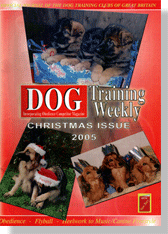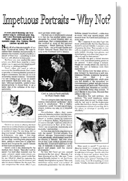Impetuous Portraits — why not?
(from Dog Training Weekly, December 2005)
As published in

A vivid pencil drawing can be a perfect way to celebrate your dog, and Carol Rowlands specialises in them – when she’s not on the operatic stage. Dog Training Weekly catches up with her
Nearly all of us take photographs of our dogs. It’s almost an instinct. We want to capture their character and personality, to preserve the moment, maybe to build up a record of their lives – something to look back on with affection in later years.
But have you ever reached the point where you think there must be a more artistic way to approach this visual record? A drawing or painting, perhaps?
That’s when you need to talk to someone like Carol Rowlands. She’s made a speciality of drawing detailed portraits of dogs to commission, and she can do it on remarkably slender evidence. “Sometimes I’ve had nothing to go on but an ancient and battered black and white snap,” she says, “although if possible, I prefer to have several pictures to choose from, to get a better idea of the subtleties of the dog’s personality.”
Carol is not alone in offering this kind of service (a number of artists now specialise in animal portraits), but she’s interesting in a number of ways. For one thing, she’s a dog lover herself. “I really think that makes a difference,” she says. “I find dogs constantly fascinating. I’ve spent hours with my own dogs – watching them, playing with them, getting to know how to judge their moods and recognise the special features of their look and personality.”
Distinctive medium
Carol’s work is also distinctive for the medium she’s chosen. “Basically I work in pencil. I’ve tried other materials over the years – oil paint, pastel, water colours, you name it – but somehow, pencil works best for me. I find it’s ideal for capturing the intricacies of a dog’s coat, for instance, and also for elusive features like the eyes. You can compromise the whole effect if you don’t get these details right.”
 The third way in which Carol is unusual is in that she has another artistic career alongside the animal drawing: she’s an opera singer. She’s a mezzo-soprano, and has worked at most of the regional companies – Welsh National, Scottish, Opera North – and at Covent Garden and English National Opera. She’s has also sung on the Continent and in America.
The third way in which Carol is unusual is in that she has another artistic career alongside the animal drawing: she’s an opera singer. She’s a mezzo-soprano, and has worked at most of the regional companies – Welsh National, Scottish, Opera North – and at Covent Garden and English National Opera. She’s has also sung on the Continent and in America.
“I’m not going to claim that I’m a top-ranking international performer,” she’s quick to emphasise. “It’s a highly competitive world. I’m just one of many singers making my way in a crowded market.”
Nevertheless, she’s had some extremely flattering reviews over the years, particularly in relation to recent roles she’s played in modern operas by composers such as Benjamin Britten. “A performance of massive strength,” said one writer about her performance in Turn of the Screw. “Carol was exceptional, dramatically and musically,” said another.
So how does she fit the dog drawing in with the opera? “It’s not actually that difficult,” she says. “I’m involved in singing work periodically, which means I have time for drawing in between. And even when I’m on tour, I can work on pictures during my free time. It’s not as if I need much in the way of materials or equipment – just a pencil and paper, and the source photographs.”
How it started
So how did Carol get into animal drawing in the first place? “Basically I’ve been drawing all my life,” she says. “I was never formally trained in art, but I was already drawing before my teens.” Her most ambitious early work was a kind of multimedia presentation that she did as a birthday present for a friend – a little story in music, told over several pages, with musical score (by Carol) and paintings on every page.
“But I suppose it was after I got into music professionally that the dog drawing started in earnest. Initially it was just a way of passing the time. Then people on tour with me caught on to the fact that I could do quite realistic drawings from photos, and started getting me to draw their dog or cat – often as a gift for their partner.”
Gradually she gave a formal structure to the work, and started putting prices on the pictures. “I don’t charge a fortune. People can’t usually afford a lot, and I try to keep the cost in balance with their expectations.”
More recently Carol has taken all this a step forward by launching a web site, Impetuous Portraits, to promote the service. It gives you full details of the procedure for commissioning a portrait, and also includes some examples of Carol’s work. [Note 2015: This website has now been discontinued.] That includes cats as well as dogs, she points out, and she’s also comfortable doing other animals. “If you’d like me to do a horse, I’m more than willing to take it on.”
Regarding the web address, she explains: “The word ‘impetuous’ makes more sense when you see it written down, with the ‘pet’ part in red. But it also sums up the idea that if you have a sudden whim to commission a picture of your dog, this is the place to arrange it quickly and affordably.”
How quick is quick? “I can turn a drawing round in a couple of weeks or less,” she says. She admits: “If I’m on tour, it might take a bit longer,” but she adds that it helps if clients are up-front about how soon they really need the picture. “If you let me know your partner’s birthday is six weeks away, I can fit everything in more easily.” Usually, she says, she will get into a dialogue with the person commissioning the portrait, and agree a sensible timetable. “It’s nearly always do-able.”
Various sizes
She offers the drawings in various sizes – generally between A5 and A3. She’s willing to do a collage of several different dogs on the same sheet, or several views of the same dog. Most of her pictures, though, have just a single image of the main subject, and are roughly A4 in size.
“I don’t go for a complete scene with a fully-realised background,” she says. “I prefer to focus on the dog itself, and maybe just include a bit of contextual detail – part of a tree, or some foliage, or a favourite toy of the dog, or another animal.”
Could she draw an entire scene, maybe with a landscape as a backdrop, or with people in it? “Well, anything is possible,” Carol says, adding with a laugh, “If that’s what you really want, make me an offer!” But she says she prefers to stick with her tried and tested technique. “I feel it makes sense to have a distinctive style that marks out my work, and to aim for an effect I know I can achieve.”
As you can see from the examples in our pictures, Carol’s work is certainly vividly lifelike. “It’s a strange thing,” she says, “but a pencil drawing of a dog on its own can be more realistic than a colour picture that includes the background as well. I suppose that’s what art is all about.”
She adds: “It’s hard to convey the exact relationship between my pictures and reality. I don’t set out to re-create a photograph. There wouldn’t be much point. But I do try to stay faithful to the essence of the original. I hope my pictures are somehow more than real, and yet completely lifelike at the same time.”
Two dogs of her own
Carol has had two dogs of her own over the years, both bitches. The first, a Collie cross with a rich reddish-brown coat, was Teddy, who lived to the ripe old age of eighteen. “She was a bit manic,” Carol admits. “I think she must have had a bad time in the months before I had her. She would get very upset by visitors she didn’t know, yet would leap up above waist height in excitement on meeting an old friend. But she was wonderfully affectionate.”
Her current dog, Ruby, is a grey coarse-haired lurcher, and a very different proposition. “She’s very mild-mannered and fairly quiet,” Carol says, “but like most lurchers, she’s very independent-minded. We have a really good relationship, though.”
Ruby is a third-generation lurcher, whose ancestry is believed to include Whippet and Bedlington. She’s quite petite, and although now ten years old, she’s sometimes mistaken for a Wolfhound puppy. “But only by non-dog lovers who don’t realise that the size of the feet is a give-away.”
Since having Ruby, Carol has developed an abiding love of lurchers in general, and they have featured strongly in her output of drawings. “I know various people who look after members of Ruby’s family, and have drawn a number of her relatives. I suppose the interest has fanned out from there.”
What does Ruby think of Carol’s singing? “It doesn’t upset her, which is quite a relief,” Carol says. “In fact sometimes when I’m rehearsing at home, she joins in. Not by barking, but with a sustained, full-throated howl that must seem to her like the equivalent of singing. It’s so unfair that she’s got such a beautiful contralto without even a single singing lesson!” But does she strike the right pitch? “Well, not necessarily exactly the right note, but she does try to go up or down when I do, which is pretty remarkable.
”Perhaps surprisingly, Carol has done few portraits of her own dogs over the years. “I haven’t really had the time,” she says, but also admits: “When I’ve got a commission to fulfil and a deadline to meet, there’s a strong incentive to get the job done. I’m not so good at working in an unstructured way.”
Carol confesses that she’s slightly embarrassed at appearing in a magazine on dog training. “I wouldn’t say training was my strongest point,” she says ruefully, “but I have enormous admiration for all those – dogs and humans – who have the patience and staying power to do it properly.”
Acknowledgements to Dog Training Weekly